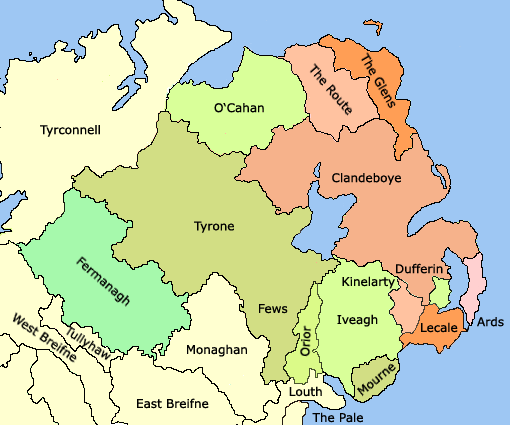Glimpse of European History Thread #101
Posted by RB Kollannur on June 12, 2021
The last stand in a conquest lasting centuries, an unexpected ending and a vacuum left behind.
Hugh Ó Néill was born around 1550 to Feardorcha Ó Néill, Baron Dungannon, and Joan Macguire. Feardorcha Ó Néill was an illegitimate son of Conn Ó Néill, the first Earl of Tyrone and the last King of Tír Eoghain. The Earldom was received when Ireland became a Kingdom in 1542. 1/10

Ó Néills hailed from the ancient Kingdom of Uí Néill in Ireland. Hugh Ó Néill’s family had their base in Cenél nEógain, centred around Tír Eoghain from late 1100s. In 1542, King Henry VIII of England was declared King of Ireland and Conn Ó Néill submitted to the new King. 2/10
Feardorcha accompanied his father to England and was designated his father’s heir by the English, much to the chargin of his half brother, Seán, possibly appointed Tánaiste (Designated heir) already. This led to a tiff between the brothers, and Feardorcha was killed in 1558. 3/10

Conn died in 1559 and Seán took control of Tyrone. Hugh grew up under the care of Henry Sidney growing up in the Pale, while his brother Brian succeeded as Baron Dungannon. Brian was killed in 1562 by the Tánaiste, Turlough Ó Néill, grandson of Conn Ó Néill’s predecessor. 4/10

After resisting English control, Seán made peace with Queen Elizabeth, who had ascended to the throne in 1558, in 1562. But as his ambitions got the better of him, he was undone by the Ó Domhnaills of Tyrconnell with English help and was later killed in 1567. 5/10

In 1568, Hugh Ó Néill returned to Ireland under the protection of Henry Sidney, now Lord Deputy of Ireland. Sidney attempted to bring in more English control in Ireland by bringing settlers to set up plantations. But he met with resistance from the English Earls in Ireland. 6/10

Hugh Ó Néill fought on the English side in putting down the rebellion by Desmond. The FitzGeralds of Desmond also looked for help from the continent, with Spain, France and Rome interested in a Catholic outcome against a Protestant England. 7/10

While fighting for the English, Hugh also developed his base in Ireland. In 1574, he married Siobhán, daughter of Aodh Ó Domhnaill of Tyrconnell. In 1595, he became the head of the Ó Néills and allied with Aodh ‘Ruadh’ Ó Domhnaill, his brother-in-law, to resist the English. 8/10

The Irish held firm for a decade, with major victories at Clontibert (1595) and Yellow Ford (1599) , and received minor military support from Spain and Rome. But the momentum reversed after the siege of Kinsale (1601), where the Spanish contingent was based. 9/10

With Spain ending their war with England in 1603, the Irish ended their war as well. Though Ó Néill and his colleagues were pardoned, they left Ireland in 1607 ending up in Rome. It left a power vacuum in Ireland, allowing for British settlers to set up plantations. 10/10

Originally tweeted by Ranjith Kollannur (@Arby_K) on June 11, 2021.
Hugh Ó Néill, Earl of Tyrone (1585-1608), Baron Dungannon (1562-1585) – The completion of English conquest of Ireland. Ó Néill and his colleagues in the Irish rebellion against the English left Ireland in 1607 leaving behind a political vacuum. This was negated by English settlers who set up plantations in their strongholds i.e Ulster. This ended up as a Protestant enclave in a predominantly Catholic Ireland. The area that was settled in early 17th century largely remains part of UK even now as Northern Ireland, while the remaining parts got its independence in the 1920s.


Leave a comment